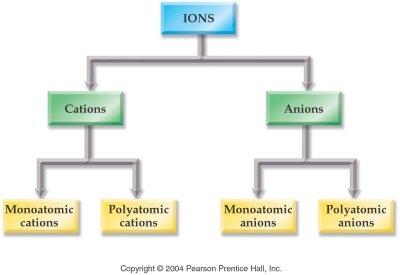
Section 7.3 of the CHEM 1001 text: Chemistry Concepts and Connections by Corwin introduces the topic of a Polyatomic ion. The College Chemistry text: General Chemistry by Zumdahl also introduces Polyatomic ions in Section 2.8. The PHSC 1001 text: Physical Science by Tillery, introduces polyatomic ions in chapter 9 and has a list of some ions in Table 9.3 on page 238. Each text provides a list of common Polyatomic ions: Corwin Table 7.3. Almost all chemistry textbooks have sections dedicated to polyatomic ions and include a list of common ions, Corwin suggests that you use flash cards listing the name on one side and the formula with its charge on the other to aide your memorization of these formulas. Most chemistry teachers require you to know some of the common polyatomic ions by the end of the course whether its be from repetition of use with a help table or from memory from the day of introduction. On the attached pages are copies of the tables from the two texts: Table 7.3 from Corwin and Table 2.4 from Hill & Petrucci.
1. Take the exploded nonmetal section of the periodic chart and draw the electron dot structures of the atoms.
2. Take the exploded nonmetal section of the periodic chart and draw the electron dot structure of the ion represented by the -ide suffix added to element's stem name.
3. From #2, take another exploded nonmetal section of the periodic chart and write symbol and the ionic charge for the -ide ions listed. (printable without boron)
4. Take the polyatomic ion section of the periodic chart, copy the formula and the charge in each square from a polyatom ion table from the chemistry textbooks or from the Internet. How many oxygens are on each ion and what is the charge oin each ion?
5. Do You notice that all the -ate poly(-oxy-)atomic ions either have three or four oxygens attached to the nonmetal given by the stem's name? Do you see any similarities in these chemical formulas? ( Invent Taylor's 3/4 -ate Polyatomic Ion Rule)(printable version with boron)
6. Using your envelope of paper atoms, assemble a reasonable dot structure of each polyatomic ion using the following criteria (You may print out the following pages and cut out the atoms: O, H, S and C, Cl, P, N ):
-ate polyatom ions have three oxygen in the formula if across the top of the periodic chart and down group 17 (VIIA). Inside the inverted L is a box of four where the -ate polyatom ion has four oxygens in the formula.
The charge on the -ate polyatomic ion is exactly the same as the nonoxygen central nonmetal's -ide monoatomic ion if all the oxygens are attached by single covalent bonds (simple covalent or coordinate covalent).
For example: Sulfide is S2- while Sulfate is SO42-
Nitrogen, Carbon, and Silicon -ate ions have charges +2 more than the -ide predicted form of N3 -, C4 - (theorical), and Si4 -(theorical-there are no -4 ions) because the ion is more stable with a double covalent bond than all single bonds (three or four electron inbalance between the protons and the electrons).
For example: Nitride is N3 - while Nitrate is NO31-
Adding a hydrogen to the oxygen in a polyatomic ion, increases the overall charge of the polyatomic ion by 1+.
For example: carbonate is CO32 - while hydrogen carbonate is HCO31 -
The polyatomic ions containing one less oxygen atom then the -ate formula has the name similiar to STEM + -ate. The -ate suffix is changed to -ite. Note all the -ite polyatomic ions have the same charge as the -ate parent ion, but one less oxygen atom.
For example: sulfate is SO42- while sulfite is SO32-
1. Suppose there is one more oxygen than the -ate formula, what is its name?
2. Suppose there is one less oxygen than the -ite formula, what is the name?